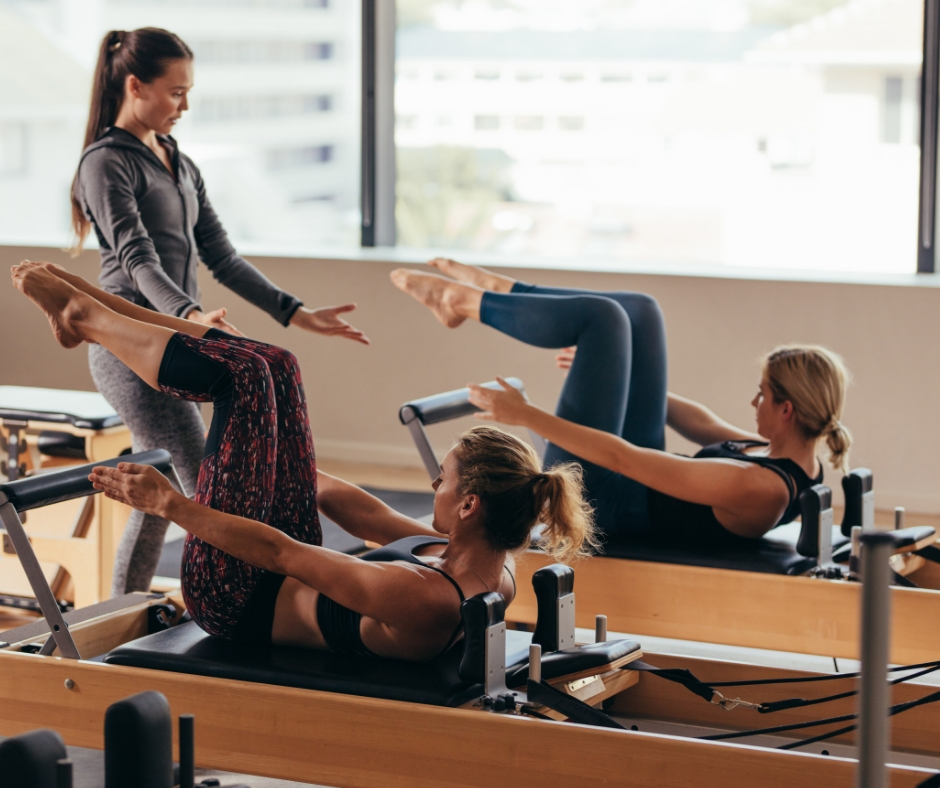While exercises and stretches can be useful in developing strength in the muscles surrounding your spine, attempting them while you have an existing injury can be painful, often with stiff or sore muscles preventing you from achieving any range of motion. Strengthening can often be a frustrating and slow process, as it requires you to remain persistent as in some cases you are repeating exercises everyday, trust that having strength in your core and back muscles can significantly help protect your spine from further injury and help you maintain better posture.
How is Pilates Beneficial For Back Pain?
To understand how important Pilates could be to help with your back pain, we’ll first walk you through what our approach to back pain relief is. Usually there are things that someone is doing everyday that can hinder their back – and sadly it can go unnoticed by the sufferer because they may have been doing it for so long that it’s an ingrained habit, or maybe it’s something they know they’re doing but aren’t clear on just how much it’s affecting them. Once we have established the cause of their back pain i.e. what injury they have, we’ll also look at how they’re standing, walking and sitting on a daily basis that could be stopping them from making a recovery.
For many people, bad posture has been a part of their life for a number of years, whether that’s letting your posture slip during the afternoon slump at work, slouching on the sofa or in bed after a long day, or spending their time on a commute (and possibly the evenings and weekends too) with their head down looking at their phone. All of these things can have an effect on your spine alignment, which can eventually cause injuries to occur as the spine becomes compressed.
If you want to learn more about why a strong core is an important part of relieving back pain for the long term, check out our article here.
How We Recommend Pilates For Patients With Back Pain
Once our treatments have helped to relieve that compression, and the patient is usually feeling either an element of pain relief or they’re already out of pain, we’ll start to introduce strengthening into their program so they can continue their recovery at home. This strengthening will help them to be able to protect their spine against further injury, as it forms almost a safety net. With poor posture, you can develop very tight and weak muscles around the back and core, as they’re out of practice with supporting correct posture. By strengthening those muscles you’ll be able to comfortably support yourself properly during the day, which will help your spine to better absorb the force of gravity a common inefficiency in so many patients that we see. We initially start by introducing basic core stability, followed by exercises they complete daily at home to support their recovery.
In our patients who have achieved pain relief and have started their strengthening, pilates, specifically reformer pilates, can be a fantastic addition to their routine which will provide a controlled and progressive form of exercise. While pilates on a mat can be good, on a reformer the resistance and tension that is used to achieve results can be much more controlled, an essential feature if you’re recovering from a back injury. Because of the equipment involved in a reformer pilates class, you will also find that classes teaching this form will be smaller and so you’ll have more 1 on 1 time with an instructor. Again, when you’re recovering from a back injury having exercises that are more tailored to you can make all the difference in how quickly you recover, and preventing any relapse. For anyone unfamiliar with reformer pilates, a reformer is the name given to the piece of equipment you use for the exercises. As opposed to a mat, this is a large frame with a bed in the middle, which can roll on wheels. Different apparatus attached to the frame allow you to perform a huge variety of exercises using the resistance of springs. The aim of this, and most versions of pilates, is to strengthen your ‘powerhouse’ muscles, including the core, back and glutes. The resistance training not only builds strength but can improve balance, coordination and flexibility.

Why Would It Be Better For Back Pain Sufferers Than Yoga?
For this reason, we’d recommend this particular exercise to our patients during their recovery process as an enjoyable and very useful class to attend. This type of exercise in our opinion can be much more useful to all types of patients over something like yoga for example. As yoga can be riskier for many back pain sufferers, some of the poses would need to be adjusted to suit the individual patient, which doesn’t always happen in a larger class setting, where most people tend to attend a yoga class.
If you’re suffering with back pain and are looking at potentially taking pilates classes, it might be worth getting evaluated by your local professional osteopath or chiropractor to start a treatment process to begin with. Following a treatment process with strengthening such as pilates can be a more effective remedy for back pain, rather than jumping straight into pilates without initially seeking help for your back injury. If you’re based in the London area, call us on 0203 947 3222 or email us at info@themayfairclinic.com to book in your appointment.
Contact Us.
Email Us
info@themayfairclinic.com
Call Us
0203 947 32 22
Clinic Address
4 Cavendish Square, London, W1g 0PG.